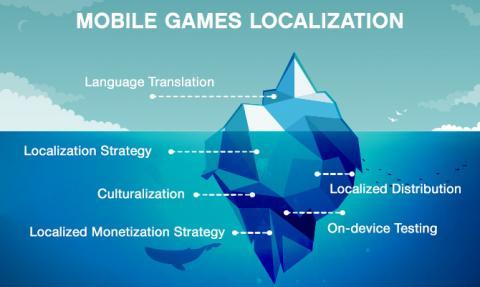6 reasons for the failure of the mobile game in the international market
According to forecasts of the Wall Street Journal , in 2017 the volume of the global mobile gaming market will increase by 8 times compared with 2010 - from $ 3.77 billion to $ 29.6 billion. Today, the Asia-Pacific region is headed by China. and Japan. It accounts for 48% of the income of the entire industry, as well as 3 times more players than in the second largest region - North America.

Given these data, it is not surprising that every year more and more mobile developers are trying to promote their games abroad. But only a few units succeed.
This is partly due to the fact that the development of mobile games has become the gold rush of our time. Developers from around the world flooded the market in the hope of getting rich quick. Therefore, it is natural that competition has become much tougher in both domestic and foreign markets.
')
But the biggest snag is that mobile developers often underestimate the importance and pitfalls of localization.
Based on our experience in promoting games to international markets, we have identified 6 of the most common mistakes that developers make. You will significantly increase your chances of success if you do not step on this rake.

1. The lack of a clear strategy and plan
The first and most common mistake of developers is their idea of localization as a literal language translation. Before planning to enter the international market, it is necessary to develop a localization strategy that would answer the following questions:
• What factors determine the attractiveness of the market for your company (for example, population, GDP, mobile technology penetration, presence of competitors / partners, language, legislation, cultural characteristics)?
• Based on these criteria, which countries are among the ten most attractive for you?
• Is it possible to make sure that there is demand in the market before going all-in?
• What are the specific needs of each market?
• Are you able to support the product in several markets at once?
• Is it worth finding a local partner?
• What strategy should be followed when entering each individual market?
Lack of understanding and insufficiently responsible approach to localization can greatly complicate access to the international market. Therefore, your team should be well motivated to conduct an in-depth analysis of key markets and implement a strategy developed. Without the correct implementation of the strategy, your game will obviously fail, and no matter how many languages you translate it.
2. Neglect of localization in the early stages of development
Many developers postpone localization issues to the very end of the development cycle. However, they do not realize that, having already written the first line of code, they made a big mistake. Because of this, you subsequently have to redo a lot of work: return and edit the code each time a new language is added or the localization requirements are updated. This entails additional costs in the thousands, if not millions of dollars and constant release delays. To avoid unnecessary problems, your team must first decide whether internationalization is necessary. Ask yourself if your code is suitable for a preliminary localization step? Are all interface lines exported? Are non-textual elements chosen correctly: symbols, colors, currency signs, date and time formats? If you do not prepare the code for localization from the very beginning, with each written line of code the problems will become more and more.
3. Lack of cultural adaptation
To increase the chances of success in a foreign market, you need to pay a lot of attention to cultural aspects. Standard language translation is only a basic level of localization. Ideally, game content should be adapted to the local culture. “As our experience shows, in localizing game content it is not enough to limit ourselves to simple translation. Instead, it needs to be culturally adapted, ” said Craig Alexander, vice president of product development at Turbine . To create the best possible gaming experience, your translators need to understand the traditions and pop culture of the target country and know the points of contact with the audience. The same applies to non-text elements. For example, the “peace sign” is quite a normal gesture in the USA, but if you turn it over, it becomes offensive in the UK. Why the game Plants vs. Did EA's Zombies make a splash in the Chinese market? Just take a look at the next image. Pay attention to the appearance of the zombie and the Great Wall of China in the background. This is a great example of how you can win the loyalty of players by adding to the game the cultural characteristics of their region.

4. Underestimating the difficulties of global distribution
If it seems to you that the distribution channels of mobile games are the same everywhere, you are deeply mistaken. In an effort to quickly enter the international market, mobile developers often overlook this. Do you know that there is no Google Play service in China? It is replaced by about two hundred Android application stores, which creates a highly fragmented market. If you do not have a system for analyzing these channels, you will not be able to develop an effective application distribution strategy in this country. Moreover, each store is aimed at a specific audience. Your task is to take into account the characteristics of each and adapt your games accordingly. Leading companies often create different versions of applications for several online platforms. In other words, if they want to cover 20 stores, they create 20 versions of the game and marketing strategies for each of them. Because of these difficulties, many Western companies that want to enter the Chinese market prefer to cooperate with local publishers and localization companies. As soon as you prepare a localization strategy, be sure to discuss how to involve a local partner.
5. Unsuccessful monetization strategy
It may seem that the localization of the code and content of your application requires paramount attention, but do not forget about the adaptation of the revenue model. In many developing countries like China, the average user earns a lot less than in the US. Your business model must take this into account. When did the release of Plants vs. China take place? Zombies 2, the company EA has made too much emphasis on monetization, as a result of which the game was too difficult and expensive to play. Naturally, this affected the user reviews and led to a downgrade of the game from five stars to two. But the company quickly realized their mistakes and tried to correct the balance between the complexity of the game and the need for in-game purchases. Now they have much less negative reviews. Speaking about his experience at the GDC conference, head of EA Mobile in China Kun Liu said: “The Chinese market is so different from others that you have to be prepared for anything unusual from a western point of view.” Try not to repeat their mistakes.
6. Reluctance to test the game on devices and check the translation before release
Actually, this is an amateurish mistake, which is very easy to avoid, and yet we return to it again and again. Imagine your team working hard on a game, developing a localization plan, translating interface strings, and so on. But after the release, you suddenly realize that something is wrong. It turns out that too long words in the German version do not fit in the interface! Now imagine that the authorities ask you what happened, and you say: "I thought the translator would take care of this ...". Never do anything at random or rely on chance. In which case you will be responsible for the mistake that could have been avoided. Even the most experienced translators are first and foremost people. And people can make mistakes, especially in the complex, heterogeneous and rapidly developing world of mobile technologies. Be sure to test the localization on multiple mobile devices, so as not to upset users with ridiculous bugs. If your application has a bad rating, you will not be able to hide its poor quality.
Conclusion
To enter the international market is really very difficult. But a clear distribution of responsibilities and competent implementation of the strategy can open up enormous opportunities for you.

Given these data, it is not surprising that every year more and more mobile developers are trying to promote their games abroad. But only a few units succeed.
This is partly due to the fact that the development of mobile games has become the gold rush of our time. Developers from around the world flooded the market in the hope of getting rich quick. Therefore, it is natural that competition has become much tougher in both domestic and foreign markets.
')
But the biggest snag is that mobile developers often underestimate the importance and pitfalls of localization.
Based on our experience in promoting games to international markets, we have identified 6 of the most common mistakes that developers make. You will significantly increase your chances of success if you do not step on this rake.

1. The lack of a clear strategy and plan
The first and most common mistake of developers is their idea of localization as a literal language translation. Before planning to enter the international market, it is necessary to develop a localization strategy that would answer the following questions:
• What factors determine the attractiveness of the market for your company (for example, population, GDP, mobile technology penetration, presence of competitors / partners, language, legislation, cultural characteristics)?
• Based on these criteria, which countries are among the ten most attractive for you?
• Is it possible to make sure that there is demand in the market before going all-in?
• What are the specific needs of each market?
• Are you able to support the product in several markets at once?
• Is it worth finding a local partner?
• What strategy should be followed when entering each individual market?
Lack of understanding and insufficiently responsible approach to localization can greatly complicate access to the international market. Therefore, your team should be well motivated to conduct an in-depth analysis of key markets and implement a strategy developed. Without the correct implementation of the strategy, your game will obviously fail, and no matter how many languages you translate it.
2. Neglect of localization in the early stages of development
Many developers postpone localization issues to the very end of the development cycle. However, they do not realize that, having already written the first line of code, they made a big mistake. Because of this, you subsequently have to redo a lot of work: return and edit the code each time a new language is added or the localization requirements are updated. This entails additional costs in the thousands, if not millions of dollars and constant release delays. To avoid unnecessary problems, your team must first decide whether internationalization is necessary. Ask yourself if your code is suitable for a preliminary localization step? Are all interface lines exported? Are non-textual elements chosen correctly: symbols, colors, currency signs, date and time formats? If you do not prepare the code for localization from the very beginning, with each written line of code the problems will become more and more.
3. Lack of cultural adaptation
To increase the chances of success in a foreign market, you need to pay a lot of attention to cultural aspects. Standard language translation is only a basic level of localization. Ideally, game content should be adapted to the local culture. “As our experience shows, in localizing game content it is not enough to limit ourselves to simple translation. Instead, it needs to be culturally adapted, ” said Craig Alexander, vice president of product development at Turbine . To create the best possible gaming experience, your translators need to understand the traditions and pop culture of the target country and know the points of contact with the audience. The same applies to non-text elements. For example, the “peace sign” is quite a normal gesture in the USA, but if you turn it over, it becomes offensive in the UK. Why the game Plants vs. Did EA's Zombies make a splash in the Chinese market? Just take a look at the next image. Pay attention to the appearance of the zombie and the Great Wall of China in the background. This is a great example of how you can win the loyalty of players by adding to the game the cultural characteristics of their region.

4. Underestimating the difficulties of global distribution
If it seems to you that the distribution channels of mobile games are the same everywhere, you are deeply mistaken. In an effort to quickly enter the international market, mobile developers often overlook this. Do you know that there is no Google Play service in China? It is replaced by about two hundred Android application stores, which creates a highly fragmented market. If you do not have a system for analyzing these channels, you will not be able to develop an effective application distribution strategy in this country. Moreover, each store is aimed at a specific audience. Your task is to take into account the characteristics of each and adapt your games accordingly. Leading companies often create different versions of applications for several online platforms. In other words, if they want to cover 20 stores, they create 20 versions of the game and marketing strategies for each of them. Because of these difficulties, many Western companies that want to enter the Chinese market prefer to cooperate with local publishers and localization companies. As soon as you prepare a localization strategy, be sure to discuss how to involve a local partner.
5. Unsuccessful monetization strategy
It may seem that the localization of the code and content of your application requires paramount attention, but do not forget about the adaptation of the revenue model. In many developing countries like China, the average user earns a lot less than in the US. Your business model must take this into account. When did the release of Plants vs. China take place? Zombies 2, the company EA has made too much emphasis on monetization, as a result of which the game was too difficult and expensive to play. Naturally, this affected the user reviews and led to a downgrade of the game from five stars to two. But the company quickly realized their mistakes and tried to correct the balance between the complexity of the game and the need for in-game purchases. Now they have much less negative reviews. Speaking about his experience at the GDC conference, head of EA Mobile in China Kun Liu said: “The Chinese market is so different from others that you have to be prepared for anything unusual from a western point of view.” Try not to repeat their mistakes.
6. Reluctance to test the game on devices and check the translation before release
Actually, this is an amateurish mistake, which is very easy to avoid, and yet we return to it again and again. Imagine your team working hard on a game, developing a localization plan, translating interface strings, and so on. But after the release, you suddenly realize that something is wrong. It turns out that too long words in the German version do not fit in the interface! Now imagine that the authorities ask you what happened, and you say: "I thought the translator would take care of this ...". Never do anything at random or rely on chance. In which case you will be responsible for the mistake that could have been avoided. Even the most experienced translators are first and foremost people. And people can make mistakes, especially in the complex, heterogeneous and rapidly developing world of mobile technologies. Be sure to test the localization on multiple mobile devices, so as not to upset users with ridiculous bugs. If your application has a bad rating, you will not be able to hide its poor quality.
Conclusion
To enter the international market is really very difficult. But a clear distribution of responsibilities and competent implementation of the strategy can open up enormous opportunities for you.
Source: https://habr.com/ru/post/281340/
All Articles